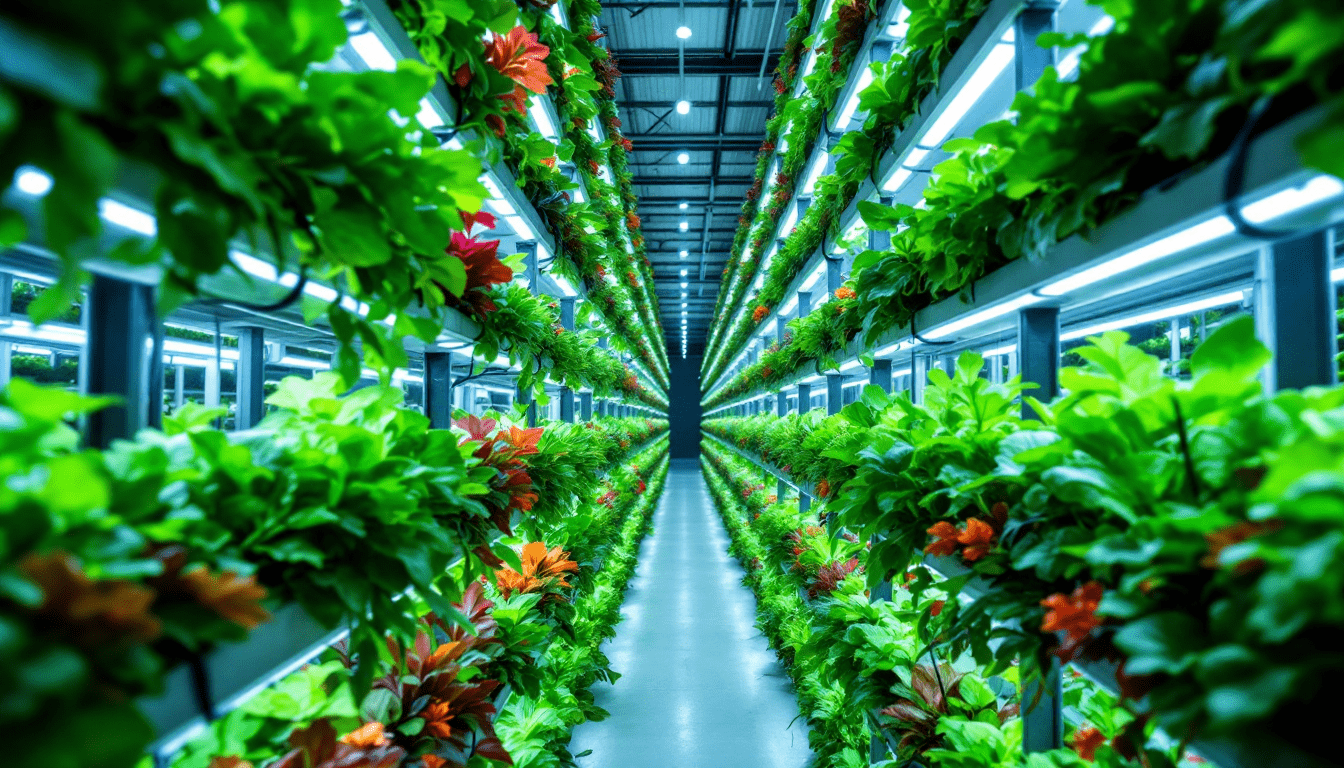High-Efficiency Vertical Farming

The prospect of achieving one hundred times greater crop yield per square foot through vertical farming represents an extraordinary engineering challenge that would require revolutionary advances across multiple scientific disciplines. Whilst current vertical farming technology achieves perhaps ten to twenty-fold improvements for specific leafy crops, reaching hundred-fold productivity would demand fundamental breakthroughs in photosynthetic efficiency, architectural engineering, and energy systems that remain theoretical rather than demonstrated.
The mathematics of such productivity gains illuminate the scale of innovation required. Traditional agricultural yields for wheat average approximately 3 tonnes per hectare annually. A hundred-fold improvement would necessitate producing 300 tonnes from the same footprint—equivalent to stacking productive capacity across multiple vertical levels whilst simultaneously accelerating growth cycles far beyond natural limits. This would require not merely incremental improvements to existing controlled environment agriculture, but paradigm-shifting discoveries in plant biology and engineering systems.
British research institutions investigating advanced vertical farming concepts recognise that achieving such yields would require solving multiple interconnected challenges. The John Innes Centre's work on photosynthetic efficiency, investigating whether the fundamental quantum yield of photosynthesis might be improved beyond its evolved maximum of approximately 12%, represents the type of basic research necessary. Harper Adams University's controlled environment agriculture programmes explore how far growth cycles might be compressed through environmental manipulation, though current achievements remain far from hundred-fold improvements.
Photosynthetic Enhancement and the Light Utilisation Challenge
The primary constraint limiting vertical farming productivity remains photosynthetic efficiency—the conversion of light energy into chemical energy within plants. Natural photosynthesis captures merely 3-6% of incident solar radiation under optimal conditions, with most light either reflected, transmitted through leaves, or absorbed by non-photosynthetic pigments. Achieving hundred-fold yield improvements would require revolutionary enhancement of this fundamental biological process.
Theoretical approaches to photosynthetic enhancement focus on several potential pathways. The introduction of alternative photosynthetic mechanisms, such as incorporating components from more efficient photosynthetic bacteria or algae, could theoretically improve quantum efficiency. Some cyanobacteria demonstrate marginally superior light harvesting complexes that might be engineered into crop plants, though successful integration remains undemonstrated. The C4 photosynthetic pathway, naturally more efficient than the C3 pathway used by most crops, represents another theoretical enhancement route, though engineering C4 photosynthesis into C3 crops has proven extraordinarily complex despite decades of research.
Spectral optimisation offers more near-term potential. Plants evolved to utilise sunlight's broad spectrum, but LED technology enables delivery of only photosynthetically useful wavelengths. Current commercial vertical farms employ red and blue LEDs matching chlorophyll absorption peaks, achieving electrical-to-photosynthetic conversion efficiencies approaching 30%—far superior to the 2-3% achieved with broad-spectrum lighting. However, reaching hundred-fold productivity would require near-perfect matching of light delivery to photosynthetic capacity throughout the canopy, a challenge complicated by mutual shading and the inverse square law of light intensity.
The theoretical limit of photosynthetic productivity, assuming perfect conditions and enhanced efficiency, might approach 50-60 tonnes of dry biomass per hectare annually according to crop modelling studies. This represents perhaps a twenty-fold improvement over current field agriculture, suggesting that photosynthetic enhancement alone cannot deliver hundred-fold yield gains. Additional productivity multipliers through temporal and spatial intensification would prove essential.
Architectural Innovations for Three-Dimensional Cultivation
The vertical dimension offers the most obvious pathway to multiplicative yield improvements, yet engineering challenges escalate rapidly with height. A hundred-fold yield improvement would theoretically require cultivation layers extending 30-40 metres vertically, assuming each layer achieves productivity matching optimised greenhouse cultivation. The structural engineering requirements for such facilities would far exceed current vertical farming infrastructure.
Load-bearing considerations dominate design constraints. Each cultivation layer requires growing medium, water, mechanical systems, and the plants themselves—potentially 100-200 kilograms per square metre. A forty-layer system would impose loads of 4,000-8,000 kilograms per square metre on the foundation, requiring industrial-grade structural engineering. Current vertical farms rarely exceed 10 layers precisely due to these structural limitations and associated costs.
Light distribution throughout vertical arrays presents fundamental physics challenges. Even with perfect LED positioning, lower layers receive reduced illumination due to shadowing from upper tiers. Theoretical solutions might include light pipes channelling surface sunlight to lower levels, though transmission losses typically exceed 50% per 10 metres of pipe length. Alternatively, providing artificial lighting to each layer independently multiplies energy requirements proportionally, creating economic barriers to implementation.
Air circulation within tall growing structures would require sophisticated engineering to maintain uniform environmental conditions. Natural convection creates temperature and humidity gradients, with upper levels experiencing higher temperatures and lower CO2 concentrations as warm air rises. Forced ventilation systems capable of maintaining uniform conditions across forty vertical layers would require substantial energy inputs and complex ducting systems. Computational fluid dynamics modelling suggests that maintaining uniformity within 5% across such heights would require air exchange rates exceeding 20 volumes per hour—far higher than current vertical farm specifications.
The integration of automated systems throughout vertical structures compounds complexity. Robotic systems for seeding, transplanting, monitoring, and harvesting would need to operate reliably across multiple vertical levels, requiring sophisticated elevator systems or climbing mechanisms. The mechanical complexity and maintenance requirements of such systems currently limit most vertical farms to manual labour or simple conveyor systems.
Temporal Acceleration Through Environmental Manipulation
Compressing growth cycles represents the second multiplicative factor necessary for hundred-fold yield improvements. If vertical architecture provides a ten-fold spatial multiplication, temporal acceleration must contribute an additional ten-fold improvement. This would require reducing crop cycles to one-tenth their natural duration—growing wheat in six days rather than sixty, or producing mature tomatoes in nine days rather than ninety.
Theoretical mechanisms for growth acceleration focus on continuous optimisation of environmental conditions. Plants in nature experience suboptimal conditions most of the time—temperatures too high or low, insufficient water or nutrients, inadequate light, or pest pressure. Controlled environments eliminate these constraints, enabling continuous maximum growth rates. However, current controlled environment agriculture achieves perhaps 30-50% cycle compression for fast-growing crops, far short of the ten-fold acceleration required.
Photoperiod manipulation offers limited acceleration potential. Many plants require specific day lengths for flowering and fruiting, controlled by phytochrome photoreceptors detecting red and far-red light ratios. Whilst providing optimal photoperiods eliminates delays, fundamental biological processes cannot be indefinitely accelerated. Cell division rates, enzyme kinetics, and metabolic pathways operate within temperature-dependent limits. Excessive acceleration attempts result in incomplete development, reduced yield, or plant death.
Plant breeding specifically for rapid cycling might contribute to temporal intensification. Researchers have developed rapid-cycling Brassica varieties completing seed-to-seed cycles in 35 days rather than the typical 120 days, achieved through selection for early flowering and rapid seed maturation. However, these varieties sacrifice yield for speed, producing minimal harvestable biomass. Developing rapid-cycling varieties maintaining commercial yields remains an unsolved challenge.
Theoretical concepts for extreme growth acceleration venture into speculative territory. Some researchers propose manipulating plant circadian rhythms through precise light and temperature cycles, potentially convincing plants that multiple days have passed within 24 hours. Others investigate chemical growth regulators that might accelerate development without sacrificing yield. However, these approaches remain entirely theoretical, with no demonstrated path to ten-fold acceleration whilst maintaining productivity.
Energy Requirements and Thermodynamic Constraints
The energy demands of hundred-fold productivity vertical farming would vastly exceed current agricultural energy consumption. Photosynthesis requires approximately 8-10 moles of photons to fix one mole of CO2, equating to roughly 2,000 kilojoules of light energy per kilogram of biomass produced. For a facility producing 300 tonnes per hectare annually, theoretical minimum energy requirements would approach 600 gigajoules—before accounting for inefficiencies in light generation, distribution, and absorption.
LED efficiency continues improving, with laboratory demonstrations achieving over 50% wall-plug efficiency for converting electricity to photosynthetically active radiation. However, commercial LEDs typically operate at 30-35% efficiency, with additional losses in drivers and thermal management systems. Assuming 30% overall efficiency from electrical input to photosynthetic capture, producing 300 tonnes of biomass would require approximately 550 megawatt-hours of electricity per hectare annually.
This energy requirement exceeds the total electricity consumption of hundreds of British households. At current commercial electricity rates of £150-200 per megawatt-hour, energy costs alone would reach £82,500-110,000 per hectare annually—far exceeding the value of most agricultural products. Even assuming dramatic improvements in LED efficiency and reductions in electricity costs, energy expenses would likely remain prohibitive for all but the highest-value crops.
Climate control adds substantial additional energy demands. Maintaining optimal temperatures year-round requires both heating and cooling, with heat removal being particularly challenging. LEDs, despite efficiency improvements, still convert 50-70% of electrical input into heat. A facility consuming 550 megawatt-hours for lighting would generate approximately 300 megawatt-hours of waste heat requiring removal. Air conditioning systems capable of rejecting such heat loads would consume additional hundreds of megawatt-hours annually.
The thermodynamic limits of photosynthesis impose fundamental constraints on productivity regardless of engineering advances. The maximum theoretical efficiency of photosynthesis, limited by the energy content of photons and the biochemistry of carbon fixation, cannot exceed approximately 12% of absorbed radiation. This physical limit means that hundred-fold yield improvements cannot come solely from enhanced light utilisation—multiple productivity factors must combine multiplicatively.
Biological Limits and Genetic Modification Possibilities
The genetic potential of current crop varieties constrains productivity regardless of environmental optimisation. Wheat, rice, and maize underwent extensive breeding for yield improvement during the Green Revolution, approaching theoretical limits for harvest index—the proportion of biomass allocated to harvestable portions. Further dramatic yield improvements would require fundamental alterations to plant architecture and metabolism.
Theoretical genetic modifications for vertical farming optimisation would need to address multiple traits simultaneously. Dwarf varieties with reduced stem investment could allocate more resources to harvestable portions, though extreme dwarfing typically reduces total productivity. Altered phototropism preventing stems from bending toward light would maintain vertical orientation in artificial lighting. Modified root architecture optimised for hydroponic or aeroponic systems rather than soil exploration could improve nutrient uptake efficiency.
Metabolic engineering presents intriguing theoretical possibilities. Enhancing the catalytic rate of RuBisCO, the enzyme responsible for CO2 fixation, could accelerate photosynthesis if successful. Some researchers propose introducing carbon concentration mechanisms from algae or C4 plants, potentially doubling photosynthetic efficiency under certain conditions. However, such modifications often produce unintended consequences, with enhanced photosynthesis requiring proportional increases in water and nutrient transport capacity.
The elimination of photorespiration, a wasteful process consuming 25-30% of photosynthetic products in C3 plants, represents a longstanding goal of crop improvement. Theoretical solutions include engineering alternative biochemical pathways bypassing photorespiration or introducing bacterial enzymes achieving more efficient carbon metabolism. Several research groups have demonstrated partial photorespiration reduction in model plants, though achieving complete elimination whilst maintaining plant viability remains elusive.
Removing plant defences unnecessary in controlled environments could theoretically redirect resources toward growth. Plants invest substantially in chemical defences against herbivores and pathogens—alkaloids, phenolics, and other secondary metabolites. In pest-free vertical farms, these investments become redundant. However, completely defenceless plants often demonstrate reduced vigour for unknown reasons, suggesting that defence pathways interconnect with essential physiological processes.
Economic Realities and Resource Constraints
The economic feasibility of hundred-fold productivity vertical farming faces formidable challenges beyond technical constraints. Construction costs for facilities capable of supporting 30-40 cultivation layers would likely exceed £10,000 per square metre—roughly £100 million per hectare. Amortised over 20 years, capital costs alone would approach £5 million per hectare annually, before operating expenses.
Operating costs would dwarf those of conventional agriculture. Labour costs for managing complex vertical systems, even with extensive automation, would substantially exceed field agriculture. Skilled technicians commanding £40,000-60,000 annual salaries would replace minimum-wage agricultural workers. Energy costs, as discussed, would potentially exceed £100,000 per hectare annually. Nutrient solutions, growing media replacement, and equipment maintenance would add tens of thousands more.
The market value of agricultural products establishes ultimate economic constraints. Wheat, humanity's most important calorie crop, trades at approximately £200 per tonne. Even achieving hundred-fold yields of 300 tonnes per hectare would generate just £60,000 revenue—a fraction of operating costs. Only exceptionally high-value crops like saffron, vanilla, or certain pharmaceuticals could theoretically justify such intensive production systems.
Water efficiency represents one genuine advantage where vertical farming excels. Closed-loop hydroponic systems recycle 95% of water, reducing consumption to 5-20 litres per kilogram of produce compared to hundreds or thousands in field agriculture. In water-scarce regions, this efficiency might partially offset higher costs. However, water prices would need to exceed £10 per cubic metre—far above current rates even in water-stressed areas—to materially impact economic calculations.
The Pragmatic Path Forward
Whilst hundred-fold yield improvements remain beyond current technological capabilities, incremental advances continue improving vertical farming viability. Realistic near-term targets might include doubling or tripling current vertical farm productivity through combinations of improved LED efficiency, better environmental control algorithms, and optimised plant varieties. Such improvements could expand the range of economically viable crops from leafy greens to include tomatoes, peppers, and berries.
Research priorities should focus on constraint relaxation rather than breakthrough seeking. Reducing energy costs through improved LED efficiency and heat recovery systems offers more practical benefits than pursuing theoretical photosynthetic enhancement. Developing plant varieties specifically adapted to vertical farming environments, whilst maintaining reasonable yields, presents achievable breeding targets. Automation reducing labour costs could improve economics more than extreme yield intensification.
The role of vertical farming in future food systems likely involves complementing rather than replacing conventional agriculture. High-value, nutrient-dense crops grown near urban consumers reduce transportation costs and spoilage. Year-round local production of fresh vegetables improves food security and nutrition. However, the bulk calories feeding humanity—grains, pulses, and tubers—will continue coming from field agriculture for the foreseeable future.
British investment in vertical farming research and development could position the nation advantageously as the technology matures. Our strengths in agricultural science, engineering, and controlled environment technology provide competitive advantages. However, expectations must remain grounded in physical and economic realities rather than science fiction projections.



